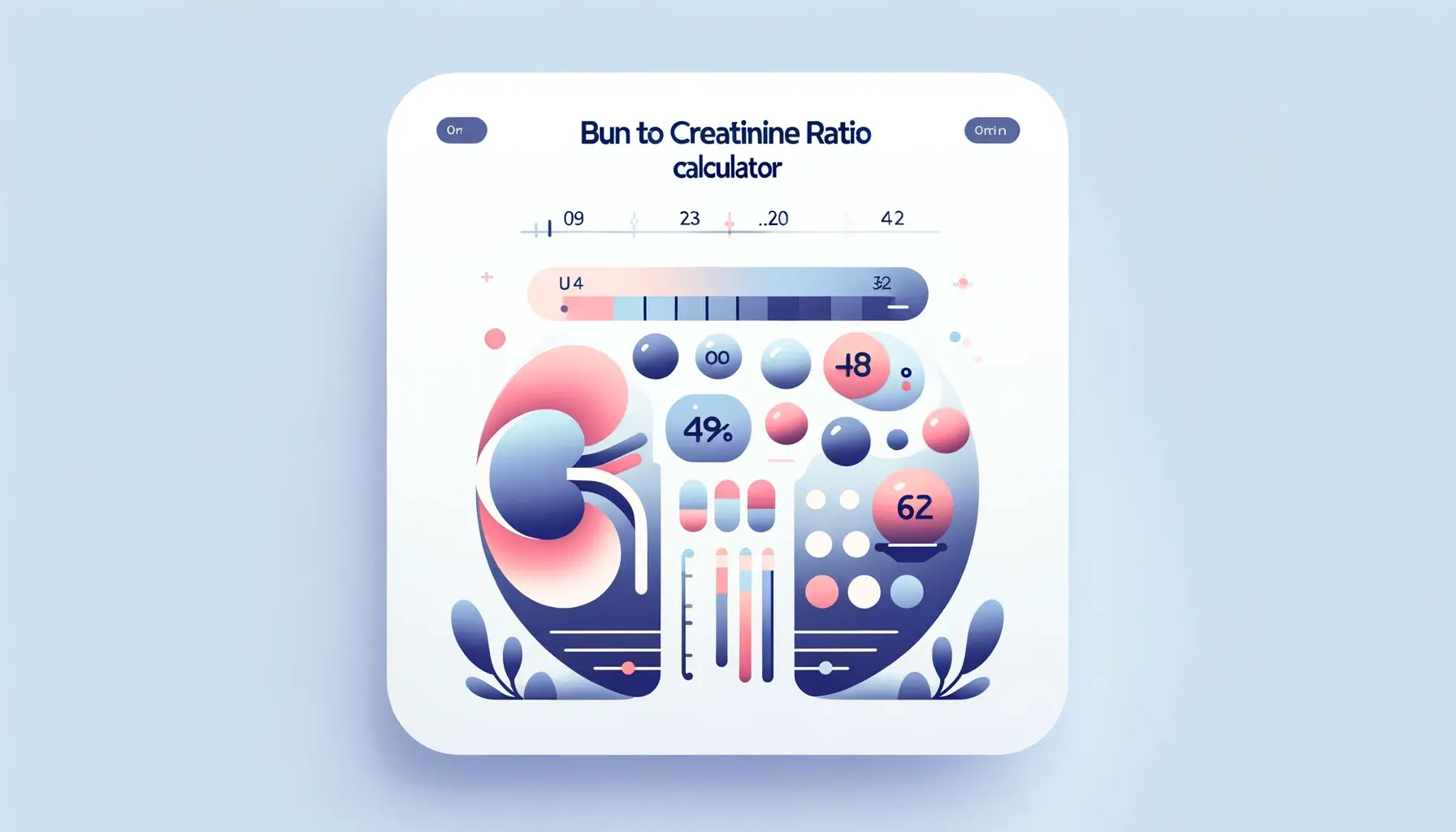The BUN (Blood Urea Nitrogen) to Creatinine Ratio is a key metric that helps clinicians evaluate renal function and distinguish potential causes of kidney-related concerns. A BUN to Creatinine Ratio Calculator enables healthcare professionals, researchers, or even informed patients to quickly transform laboratory values into an actionable ratio, guiding a better understanding of kidney health. Below is a detailed look at the ratio’s importance, how the calculator works, and when it is most beneficial.
Introduction to BUN and Creatinine
BUN measures the amount of nitrogen in the blood derived from urea—a waste product of protein metabolism generated primarily in the liver. Creatinine is another waste product produced by muscle metabolism and excreted by the kidneys. Because both are cleared by the renal system, their respective levels in the blood can reflect kidney performance. However, non-renal factors can also influence each, meaning further context is crucial when interpreting their ratio.
Purpose of the BUN to Creatinine Ratio
This ratio offers a snapshot of renal function and can sometimes pinpoint the underlying cause of abnormal lab values. For example:
- Prerenal Azotemia: A higher-than-normal ratio might indicate reduced renal blood flow due to dehydration, shock, or heart failure.
- Intrinsic Renal Issues: If the ratio is standard or near-normal, but BUN and creatinine levels are elevated, the problem could originate within the kidneys.
- Postrenal Causes: Obstructions like kidney stones or enlarged prostate (in men) might also affect the ratio pattern.
Accurate ratio calculation is thus crucial for narrowing down diagnostic possibilities and forming an initial clinical response.
Key Inputs for the Calculator
A BUN to Creatinine Ratio Calculator usually prompts users to:
- BUN: Blood Urea Nitrogen level, typically in mg/dL (in the US) or mmol/L (internationally).
- Creatinine: Serum creatinine level, also generally in mg/dL or µmol/L.
Some calculators automatically handle unit conversions if specified, ensuring the final ratio is consistent with standard ranges recognized by clinicians.
Typical BUN to Creatinine Ratio Ranges
While exact reference intervals can vary slightly among laboratories or populations, standard thresholds or ranges might hover around:
- 10:1 to 20:1 as a general “normal” ratio.
- Ratios exceeding ~20:1 are often associated with prerenal azotemia, though further tests or fluid status checks help confirm.
- Ratios under ~10:1 can occasionally suggest an intrinsic renal problem or a low-protein diet, among other reasons.
Such guidelines are never absolute rules—patient hydration, medications, and coexisting conditions influence interpretation.
Benefits of a BUN to Creatinine Ratio Calculator
- Quick Insights: Immediate ratio calculations facilitate rapid triage or early-phase diagnosis in busy clinical settings.
- Error Reduction: Automated tools decrease the chance of manual arithmetic mistakes, especially with shifting decimal places or unit conversions.
- Educational Value: Medical students or novice clinicians can practice ratio interpretation in real time, reinforcing the link between lab values and patient presentations.
- Patient Engagement: In advanced telehealth models, patients might track trends in their BUN-to-creatinine ratio, particularly those managing chronic kidney disease (CKD).
Clinical Use Cases
- Emergency Rooms: In acute settings, a spiked ratio might indicate a dehydration crisis or reduced perfusion, prompting fluid administration or cardiac function checks.
- Primary Care: Physicians monitoring a patient’s chronic conditions—like heart disease or CKD—monitor ratio trends for signs of increased kidney strain.
- Nephrology Clinics: Specialists rely on multiple data points. However, the BUN-to-creatinine ratio remains a helpful, quick reference in diagnosing or adjusting treatments.
- Nutrition Evaluations: Diet adjustments or malnutrition can shift BUN levels, and confident clinicians incorporate ratio changes into broader dietary or metabolic assessments.
Caveats and Limitations
- Multiple Influences: A patient’s diet (high protein intake) or recent activity (muscle breakdown) can alter BUN or creatinine independently of kidney function.
- Dehydration and Overhydration: Varying fluid levels heavily impact BUN reabsorption and thus shift the ratio in ways that might or might not reflect actual renal pathology.
- Confounding Conditions: GI bleeding, steroid treatments, or muscle-wasting diseases can confound ratio interpretations.
- Not a Definitive Diagnostic: The ratio is an indicator, not a sole decider. Clinicians integrate it with clinical examination, imaging, and other lab markers (like GFR estimates) for robust conclusions.
Best Practices for Effective Use
- Verify Laboratory Units: BUN vs. urea conversion or mg/dL vs. mmol/L differences can lead to confusion if not clarified. Many calculators provide unit selection or conversion fields.
- Combine with Clinical Assessment: The ratio should complement, not replace, comprehensive clinical judgment.
- Recheck Over Time: Monitoring changes in the ratio is often more insightful than a single measurement. Trends reveal if kidney issues are stabilizing, improving, or worsening.
- Document Data Source: Ensure consistent references, especially across different labs or over telemedicine platforms, to avoid mixing measurement standards.
9. Future Directions
- Real-Time Integration: Wearables or continuous blood monitoring might feed frequent BUN and creatinine data into an algorithm, producing near-live ratio updates for critical care patients.
- AI-Driven Correlations: Machine learning solutions could incorporate ratio results with broader data sets—like biomarkers, medical imaging, or genetic profiles—to predict and manage renal complications earlier.
- Patient-Centric Apps: More advanced telehealth or personal health applications could automatically parse lab results from patient uploads and compute the ratio, guiding immediate home-based guidance.
- Global Standardization: Tools might unify conversions across mg/dL, mmol/L, and other units, bridging international labs and facilitating consistent usage worldwide.
Conclusion
A BUN to Creatinine Ratio Calculator offers a fast, convenient tool to glean initial insights into possible renal conditions. Merging basic lab data informs clinical decision-making around fluid management, medication dosing, and further diagnostics. However, like many lab-based calculators, it provides just one piece of the puzzle—patients and healthcare providers should interpret ratio results within the broader tapestry of symptoms, physical exams, and complementary tests for a holistic kidney health assessment.


